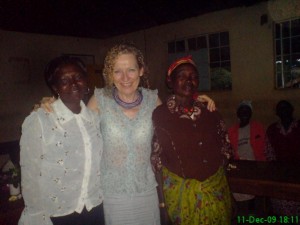In this inspirational interview, we talk with Cathleen Holland, a midwife and founder of the organisation Beyond FGM.

Your incredible story begins with a VSO programme in Pokot, Kenya. What was your original mission in Pokot and how did your aims change when you were actually there?
I was a midwifery tutor in a school of nursing run by the “Holy Rosary” sisters, a Catholic order of nuns. I came face to face with Female Genital Mutilation (FGM) when a young friend of mine, Nellie , a young Pokot girl, invited me to her “circumcision” ceremony. I was spurred on to try to do something about this deeply entrenched cultural tradition. I couldn’t bear the thought of all those other girls having to endure such torture; Nellie’s younger sisters and all the other young girls. I knew I could not simply go home and forget all about it so continued to campaign once home.
For our readers who are not familiar with female genital Mutilation (FGM), please tell us what it is and why it happens.
FGM is an ancient tradition that involves removal of part or all of the outer female genitalia. This practice varies from removal of the clitoris and or its hood, or prepuce, to removal of the clitoris, inner and most of the outer labia, or lips, and the wound sewn shut apart from a tiny hole left for urination and menstrual flow. There are varying degrees of severity dependent upon many factors such as the preferred method of the circumciser and her skill, the local custom and tradition etc.
No one really knows the origins of FGM as the practice predates history. Some of the reasons given by those who practise are hygiene, beauty, pre-requisite for marriage, rite of passage into womanhood etc. There is also an economic aspect since a father will receive a dowry for his daughter once married. Since society is largely male dominated and women have little or no say then it is generally understood that men are largely responsible for its continuation although in my experience many men do not insist and the women are sometimes the ones who perpetuate it. Men have more opportunity to travel outside of their immediate community and are exposed to different ideas in life. They meet people from other communities who do not practise FGM. I feel one cannot say it is really one or the other solely to blame these days although the roots lie within a construct of patriarchy. That is why the whole community is deserving of education against the practice.
FGM can cause chronic ill health to young teenage girls. Please tell us about these devastating effects.
One of the worst effects of FGM is obstetric fistula. This is when the baby is too big to fit through a young woman’s pelvis since she has been married at too young an age often forced into marriage. The bladder becomes trapped forming a necrosis or gangrene which destroys the tissue leaving a false passage between the vagina and bladder so that urine continually leaks out of the vagina. In worst case scenario the same can happen between the vagina and rectum so that faeces also leak through the vagina. The baby is usually stillborn. The husband often leaves his young bride and she is left to fend for herself often becoming outcast from her community with no chance of a decent life thereafter. Infertility is another consequence due to chronic infection spreading throughout the pelvis.
As a midwife, you were particularly horrified by the effects that it has on a young girl in childbirth, please tell us what they are.
The young girls are cut again during childbirth which causes further damage to these vital, sensitive parts. In remote rural areas most babies are born at home. There will be little or no light if baby is born at night so that the cuts can be more traumatic. Instruments may not be clean causing sepsis, which, if severe, can kill. Haemorrhage or severe bleeding can occur which can also kill.
How widespread is FGM? In which countries is it most prevalent?
FGM occurs about 28 African countries and in the diaspora around the world,Europe, US,Australia, Scandinavia etc. It occurs in a belt from the horn of Africa from Egypt (97% roughly), down towards Tanzania , across to West Africa where it is practised in Mali, Senegal, Sierra Leone, Nigeria plus other west African countries. It is hard to say in which countries it’s most prevalent e.g. inKenyaofficial figures say it is about 32% nationally but in certain rural areas the practice can be 95%.
In an article with The Guardian, you said, “FGM is all about patriarchy. It’s about controlling women – controlling their sexuality, controlling their libido.” Please expand on this further.
See above.
Part Two of our interview with Cathleen Holland will be published tomorrow, Monday July 25, 2011.